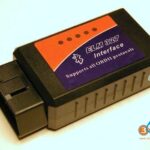Modern vehicles are sophisticated computers on wheels, relying on complex communication networks to function. This intricate system often involves numerous wires, leading to increased weight and complexity. To mitigate these issues, car manufacturers employ bus systems, and among them, CAN (Controller Area Network) stands out as a critical component. When it comes to vehicle diagnostics, OBD-II (On-Board Diagnostics II) is the standard protocol. Understanding how Can Obdii works is crucial for any automotive technician or enthusiast.
The Essence of Bus Systems in Automotive Engineering
Imagine controlling multiple functions in a car, like lights, sensors, and actuators, using individual wires for each. This would result in a wiring harness spanning kilometers, adding unnecessary bulk and cost. Bus systems offer a smarter solution by enabling multiple devices to communicate over a shared set of wires. Think of it as a highway for data, where different “vehicles” of information travel efficiently.
To illustrate, consider controlling four lamps. Without a bus system, each lamp would require a dedicated wire. However, with a basic bus system, we can significantly reduce wiring. For example, using one wire to select the lamp and another to control its on/off state. While this is a simplified example, it highlights the core advantage: transmitting more information with fewer wires.
CAN Bus: The Automotive Communication Backbone
Within the realm of automotive bus systems, CAN bus is paramount. It’s engineered to reliably transmit large volumes of data using just two wires. CAN facilitates communication between various electronic control units (ECUs) within a vehicle, such as the engine control module, transmission control module, and braking system. This robust communication network is essential for coordinating vehicle operations and gathering diagnostic information. You can delve deeper into the technical specifications of CAN bus on platforms like Wikipedia.
OBD-II Protocol: Utilizing CAN for Diagnostics
Now, let’s address the core question: can OBDII utilize CAN? The answer is a resounding yes. OBD-II is a high-level diagnostic protocol designed to access and report vehicle health information. It’s like a standardized language that diagnostic tools use to communicate with your car’s computer. Crucially, OBD-II can operate over various physical layers, and CAN bus is one of the most common and important ones.
Think of OBD-II as the language (like English) and CAN as a communication channel (like a telephone line). When you use an OBD-II scanner, it’s speaking the OBD-II protocol, and if your vehicle uses CAN for OBD-II, the scanner communicates through the CAN bus system to retrieve diagnostic data.
The OBD-II standard itself is a complex framework encompassing numerous sub-standards, communication protocols, and bus systems. CAN is a prominent transport protocol within the OBD-II specification, widely adopted by vehicle manufacturers.
Utilizing OBD-II Scanners on CAN-Enabled Vehicles
Using an OBD-II scanner on a vehicle equipped with a CAN bus system is straightforward. Simply locate the OBD-II port, which is typically found within easy reach of the driver, often under the dashboard or in the center console. Plug your OBD-II scanner into this port. Since CAN is a standard transport protocol for OBD-II, most modern scanners are inherently compatible with CAN OBDII systems.
In conclusion, understanding CAN OBDII is vital for anyone involved in automotive repair and diagnostics. CAN bus provides the robust communication network, while OBD-II offers the standardized diagnostic language. Together, they empower technicians and enthusiasts to effectively diagnose and maintain modern vehicles. Using an OBD-II scanner on a CAN-equipped vehicle is generally plug-and-play, making vehicle diagnostics more accessible than ever.


